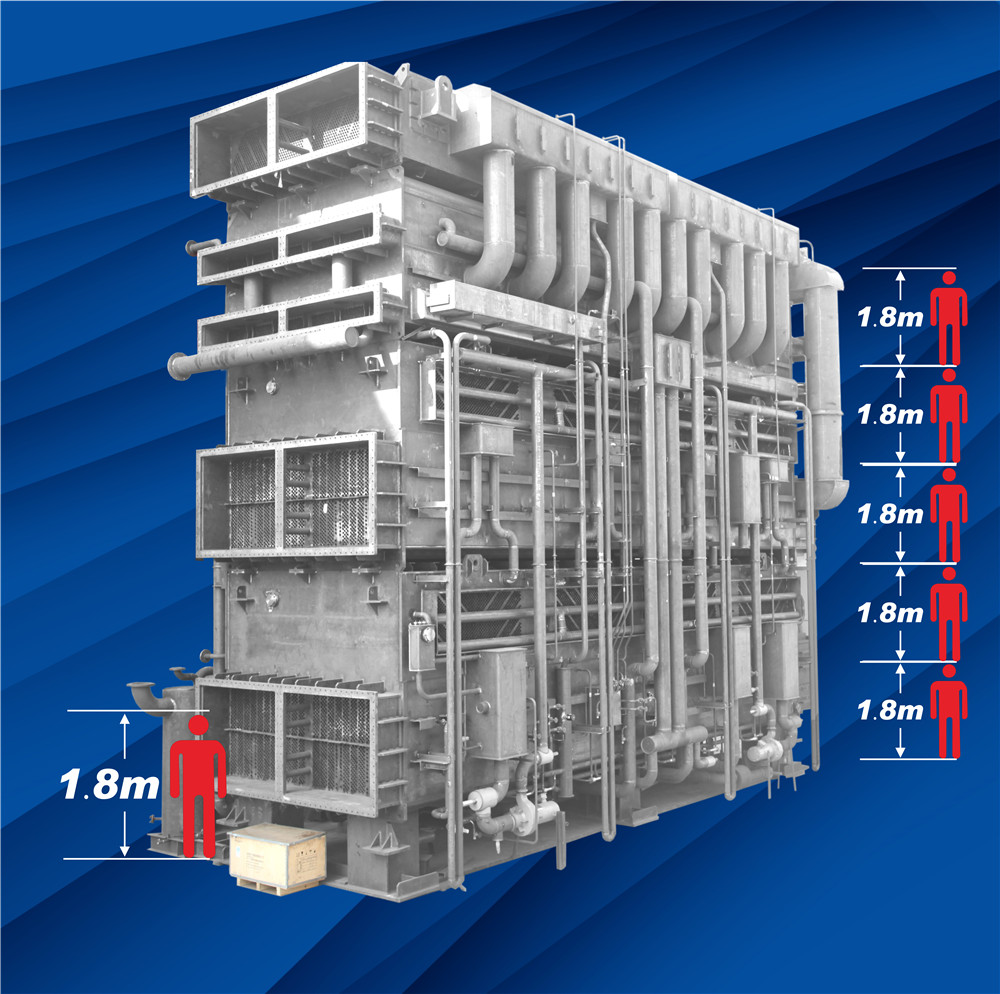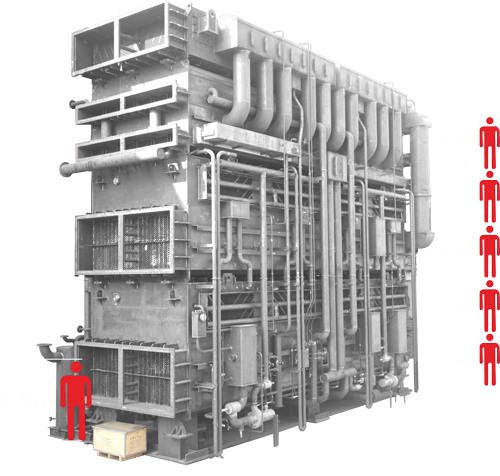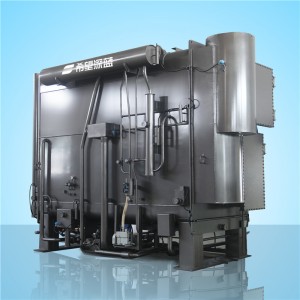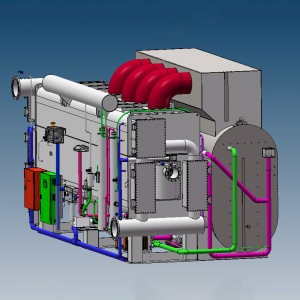
Products
LiBr Absorption Heat Pump
LiBr absorption heat pump is one kind of device driven by high grade heat sources, such as steam, HT hot water, natural gas, etc. to recover heat from LT heat sources, such as waste hot water, for the purpose of producing hot water for district heating and industrial process.
In the waste heat recovery process, the refrigerant water in evaporator absorbs heat from the waste hot water and evaporates in refrigerant vapor which enters the absorber. After absorbing the refrigerant vapor, the concentrated solution in absorber becomes diluted solution and releases the absorbed heat, which in turns heats the hot water as a heating medium to a temperature required for heating effect. Meanwhile, the diluted solution is delivered to generator by solution pump, where the diluted solution is heated by driven steam (or HT hot water) turns into concentrated solution and delivered back to absorber. The concentration process generates refrigerant vapor which enters the condenser where it is used to heat the hot water to the required temperature. Meanwhile, the refrigerant vapor condenses into refrigerant water, which enters evaporator and absorbs the heat from waste hot water. Repeating of this cycle constitutes a continuous heating process.

For the HT heat source, dual effect LiBr absorption heat pump can be adopted.
The refrigerant water in evaporator absorbs heat from the waste hot water and evaporates in refrigerant vapor which enters the absorber. After absorbing the refrigerant vapor, the concentrated solution in absorber becomes diluted solution and releases the absorbed heat, which in turns heats the hot water as a heating medium to a temperature required for heating effect. Meanwhile, the diluted solution is delivered by solution pump via LT heat exchanger, Ht heat exchanger to HTG, where it’s heated by heat source, releases refrigerant vapor and make solution concentrates to intermediate solution.
After releasing heat in HT heat exchanger, the intermediate solution enters LTG, where it is heated by HT refrigerant vapor from HTG, releases refrigerant vapor and concentrates in concentrated solution.
After the HT refrigerant vapor generated in HTG heats the intermediate solution in LTG, it becomes condensate water, which enters condenser together with the refrigerant vapor generated in LTG, and heats the hot water to a required temperature. At this point, both HT and LT refrigerant vapor condense into water.
After refrigerant water entering evaporator via throttle to absorb the heat from waste heat from waste hot water, it becomes refrigerant vapor entering absorber. The concentrated solution in LTG returns to absorber via LT heat exchanger to absorb refrigerant vapor and condenses into water.
Repeating of this cycle by LiBr absorption heat pump constitutes a continuous heating process.


Normally, Class II LiBr absorption heat pump is one kind of LT waste heat-driven device, which absorbs heat from waste hot water to generate hot water with a higher temperature than driven waste hot water. The most typical feature for this kind heat pump is that it can generate hot water with a higher temperature than waste hot water without other heat sources. In this condition, waste hot water is also the heat source. This is why Class II LiBrabsorption heat pump is known as temperature boosting heat pump.
The waste hot water enters generator and evaporator in series or in parallel way. The refrigerant water absorbs the heat from waste hot water in evaporator, then it evaporates into refrigerant vapor and enters absorber. The concentrated solution in absorber becomes diluted solution and releases heat after absorbing the refrigerant vapor. The absorbed heat heats the hot water to the required temperature.
On the other hand, the diluted solution enters generator after heat exchanging with the concentrated solution via heat exchanger and returns to generator, where it is heated by the waste hot water and concentrated into concentrated solution, then delivered to absorber. The refrigerant vapor produced in generator is delivered to condenser, where it is condensed into water by the low temperature cooling water and delivered to evaporator by refrigerant pump.
Repeating of this cycle by LiBr absorption heat pump constitutes a continuous heating process.

Waste Heat Recovery. Energy Conservation&Emission Reduction
It can be applied to recover LT waste hot water or LP steam in thermal power generation, oil drilling, petrochemical field, steel engineering, chemical processing field, etc. It can utilize river water, groundwater or other natural water source, converting LT hot water into HT hot water for the purpose of district heating or process heating.
Dual effect (Used for Cooling/Heating)
Driven by natural gas or steam, dual effect absorption heat pump can recover waste heat with very high efficiency (COP can reach 2.4). It is equipped with both heating and cooling function, especially applicable to concurrent heating/cooling demand.
Two Phase Absorption&Higher Temperature
Class II two phase absorption heat pump can improve waste hot water temperature to 80°C without other heat source.
Intelligent Control&Easy Operation
Fully automatic control, it can realize one-button On/Off, load regulation, solution concentration limit control and remote monitoring.
• Fully-automatic control functions
The control system (AI, V5.0) is featured by powerful and complete functions, such as one-key start up/shutdown, timing on/off, mature safety protection system, multiple automatic adjustment, system interlock, expert system, human machine dialogue(multi languages), building automation interfaces, etc.
• Complete unit abnormality self-diagnosis and protection function
The control system (AI, V5.0) features 34 abnormality self-diagnosis&protection functions. Automatic steps will be taken by system according to level of an abnormality. This is intended to prevent accidents, minimize human labor and ensures a sustained, safe and stable operation of chiller.
• Unique load adjustment function
The control system (AI, V5.0) has a unique load adjustment function, which enables automatic adjustment of chiller output according to actual load. This function not only helps to reduce startup/shutdown time and dilution time, but also contributes to less idle work and energy consumption.
• Unique solution circulation volume control technology
The control system (AI, V5.0) employs an innovative ternary control technology to adjust solution circulation volume. Traditionally, only parameters of generator liquid level are used to control of solution circulation volume. This new technology combines merits of concentration&temperature of concentrated solution and liquid level in generator. Meanwhile, an advanced frequency-variable control technology is applied to solution pump to enable unit to achieve an optimal circulated solution volume. This technology improves operating efficiency and reduces startup time and energy consumption.
• Solution concentration control technology
The control system (AI, V5.0) uses a unique concentration control technology to enable real-time monitoring/control of concentration and volume of concentrated solution as well as hot water volume. This system can maintain chiller under safe and stable at high-concentration condition, improve chiller operating efficiency and prevent crystallization.
• Intelligent automatic air purge function
The control system (AI, V5.0) can realize real-time monitoring of vacuum condition and purge out the non-condensable air automatically.
• Unique dilution stop control
This control system (AI, V5.0) can control operation time of different pumps required for dilution operation according to concentrated solution concentration, ambient temperature and remaining refrigerant water volume. Therefore, an optimal concentration can be maintained for the chiller after shutdown. Crystallization is precluded and chiller re-start time is shortened.
• Working parameter management system
Through interface of this control system (AI, V5.0), operator can perform any of following operations for 12 critical parameters relating to chiller performance: real-time display, correction, setting. Records can be kept for historical operation events.
• Unit fault management system
If any prompt of occasional fault is displayed on operation interface, this control system(AI, V5.0) can locate and detail fault, propose a solution or trouble shooting guidance. Classification and statistical analyses of historical faults can be conducted to facilitate maintenance service provided by operators.












